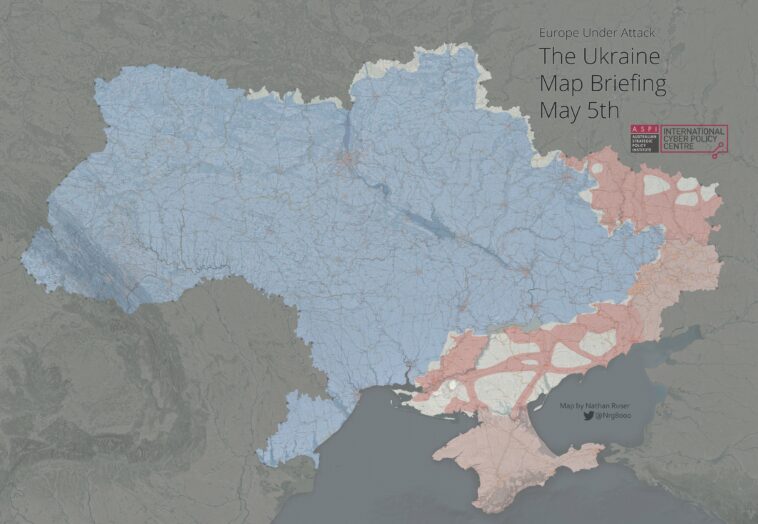Ukrainian troops hold defense of Azovstal, fighting rages on perimeter. Fierce fighting continues at the Azovstal steelworks in Mariupol. Russian forces violated a ceasefire called to evacuate civilians, head of the Mariupol patrol police Mykhailo Vershynin said.
“The situation is very difficult. Fighting rages on the perimeter of the steelworks,” Verhsynin told Ukraine’s public broadcaster Suspilne. The Azov regiment posted a video on Telegram showing the Azovstal plant being stormed by the Russian troops. They use aircraft, artillery, and ground forces. The Ukrainian troops hold the defense.
Ukrainian counterattacks on Izyum axis. The Ukrainian troops went on counterattack against the Russian forces in two hotspots on the frontline, the Commander-in-Chief of the Ukrainian Armed Forces Valeriy Zaluzhnyi said on Telegram on May 5.
Zaluzhnyi said he briefed his American counterpart Mark Milley, the Chairman of the Joint Chiefs of Staff of the U.S. on operative situation in Ukraine.
“[I briefed Gen. Milley that] Russia moved forces into the Luhansk axis where fierce fighting continues near Popasna, Kreminna, and Torske. Also, the Ukrainian troops launched a counterattack on the Kharkiv and Izyum axes,” General Zaluzhnyi said.
Russia had resumed the use of cruise missiles, the Commander-in-Chief of the Ukrainian Armed Forces proceeded. Russia aims to break logistical supply routes for moving military-technical assistance to Ukraine.
“On May 3, Russia struck Ukraine with 14 cruise missiles from TU-160 strategic bombers in the Caspian Sea. A day earlier, Russia launched eight cruise missiles on Ukraine. It would be timely to supply Ukraine with multiple launch rocket systems M142 HIMARS and М270 MLRS,” Zaluzhnyi said.
Donor’s conference for Ukraine in Warsaw. Zelenskyi’s address. President Zelenskyi envisioned global support for Ukraine in war time and after the war ends. “Ukraine, Europe and the entire free world are on the way to a joint victory,” he said. “[We need] sufficient financial resources to provide Ukrainian men and women with everything they need as the war continues,” Zelenskyi went on. “We are charting a large-scale recovery plan for Ukraine after the war. We need a strategic international support plan, a modern analogue of the historic Marshall Plan,” the President said.
“Reconstruction of Ukraine must now become the same historical example in our time and for the future as the restoration of European countries after World War II. These investments, if they are fast, if they are sufficient, will mean that millions of our people who became displaced because of this war will be able to return home.”
Zelenskyi suggested that Ukraine’s partners take patronage over the regions, cities or sectors of economy damaged by Russia’s war. The project has the potential to “make history as an example of interaction and partnership between the free world, between the regions, cities and companies of Europe and democratic countries.”
Ukraine needs to quickly move toward the European Union, Zelenskyi said. He called to grant Ukraine the candidate status in war time and fast-track its membership application.
Ukraine in Flames #56: Energy independence as a path to a more secure Europe
Due to Russia’s invasion of Ukraine, Europe is trying to find a way to stop paying the aggressor $850 million a day for energy supplies. Sanctions are clearly not enough, so a full boycott on imports from Russia is under serious consideration. 53% of total Russian oil exports were consumed by Europe before the war. The EU is the largest consumer of Russian raw materials that also pays market price for them, unlike China that had discounts from Russia.
Part of the sixth package of EU sanctions, the oil embargo, represents the most impactful penalty the bloc has imposed on Russia since the start of Ukraine’s war on 24 February and has the potential to deprive the Kremlin of one of its most reliable sources of income.
The EU has been focusing for weeks on how to wean itself off Russian oil and gas. It has already pledged to reduce gas imports by two-thirds by the end of 2022 and now plans to phase out crude oil over six months and refined products by the end of 2022. Yesterday the EU proposed some of its toughest measures yet against Russia, including a total ban on oil imports and sanctions on war crimes suspects. Russian crude oil would be phased out within six months, Ursula von der Layen said. Hungary has rejected the proposal as unacceptable and the Czech and Slovak governments want a transition period.
Will the EU reach consensus to give up Russian oil and gas? In Ukraine in Flames #56 energy experts prove it should. Europe’s energy independence from the Kremlin is a guarantee of security for the entire European continent.
Speakers:
Olena Pavlenko, President of DiXi Group
Valeriia Izhyk, Senior Energy Expert in Ecoaction
Leonid Unigovskyi, Director General of NAFTOGAZBUDINFORMATYKA Ltd




